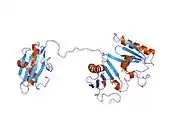Macrophage-capping protein
Macrophage-capping protein (CAPG) also known as actin regulatory protein CAP-G is a protein that in humans is encoded by the CAPG gene.[5][6][7]
Function
This gene encodes a member of the gelsolin/villin family of actin-regulatory proteins.[8] The encoded protein reversibly blocks the barbed ends of F-actin filaments in a Ca2+ and phosphoinositide-regulated manner, but does not sever preformed actin filaments. By capping the barbed ends of actin filaments, the encoded protein contributes to the control of actin-based motility in non-muscle cells. Alternatively spliced transcript variants have been observed, but have not been fully described.[7]
References
- GRCh38: Ensembl release 89: ENSG00000042493 - Ensembl, May 2017
- GRCm38: Ensembl release 89: ENSMUSG00000056737 - Ensembl, May 2017
- "Human PubMed Reference:". National Center for Biotechnology Information, U.S. National Library of Medicine.
- "Mouse PubMed Reference:". National Center for Biotechnology Information, U.S. National Library of Medicine.
- Dabiri GA, Young CL, Rosenbloom J, Southwick FS (Sep 1992). "Molecular cloning of human macrophage capping protein cDNA. A unique member of the gelsolin/villin family expressed primarily in macrophages". J Biol Chem. 267 (23): 16545–52. PMID 1322908.
- Pellieux C, Desgeorges A, Pigeon CH, Chambaz C, Yin H, Hayoz D, Silacci P (Jul 2003). "Cap G, a gelsolin family protein modulating protective effects of unidirectional shear stress". J Biol Chem. 278 (31): 29136–44. doi:10.1074/jbc.M300598200. PMID 12754261.
- "Entrez Gene: CAPG capping protein (actin filament), gelsolin-like".
- Ghoshdastider, U; Popp, D; Burtnick, L. D.; Robinson, R. C. (2013). "The expanding superfamily of gelsolin homology domain proteins". Cytoskeleton. 70 (11): 775–95. doi:10.1002/cm.21149. PMID 24155256. S2CID 205643538.
Further reading
- Southwick FS (1995). "Gain-of-function mutations conferring actin-severing activity to human macrophage cap G". J. Biol. Chem. 270 (1): 45–8. doi:10.1074/jbc.270.1.45. PMID 7814409.
- Mishra VS, Henske EP, Kwiatkowski DJ, Southwick FS (1995). "The human actin-regulatory protein cap G: gene structure and chromosome location". Genomics. 23 (3): 560–5. doi:10.1006/geno.1994.1543. PMID 7851883.
- Maruyama K, Sugano S (1994). "Oligo-capping: a simple method to replace the cap structure of eukaryotic mRNAs with oligoribonucleotides". Gene. 138 (1–2): 171–4. doi:10.1016/0378-1119(94)90802-8. PMID 8125298.
- Hirano T, Kobayashi R, Hirano M (1997). "Condensins, chromosome condensation protein complexes containing XCAP-C, XCAP-E and a Xenopus homolog of the Drosophila Barren protein". Cell. 89 (4): 511–21. doi:10.1016/S0092-8674(00)80233-0. PMID 9160743. S2CID 15061740.
- Cabello OA, Eliseeva E, He WG, et al. (2002). "Cell cycle-dependent expression and nucleolar localization of hCAP-H". Mol. Biol. Cell. 12 (11): 3527–37. doi:10.1091/mbc.12.11.3527. PMC 60273. PMID 11694586.
- Van Impe K, De Corte V, Eichinger L, et al. (2003). "The Nucleo-cytoplasmic actin-binding protein CapG lacks a nuclear export sequence present in structurally related proteins". J. Biol. Chem. 278 (20): 17945–52. doi:10.1074/jbc.M209946200. PMID 12637565.
- De Corte V, Van Impe K, Bruyneel E, et al. (2005). "Increased importin-beta-dependent nuclear import of the actin modulating protein CapG promotes cell invasion". J. Cell Sci. 117 (Pt 22): 5283–92. doi:10.1242/jcs.01410. PMID 15454578.
- Watari A, Takaki K, Higashiyama S, et al. (2007). "Suppression of tumorigenicity, but not anchorage independence, of human cancer cells by new candidate tumor suppressor gene CapG". Oncogene. 25 (56): 7373–80. doi:10.1038/sj.onc.1209732. PMID 16767159.
- Chi A, Valencia JC, Hu ZZ, et al. (2007). "Proteomic and bioinformatic characterization of the biogenesis and function of melanosomes". J. Proteome Res. 5 (11): 3135–44. doi:10.1021/pr060363j. PMID 17081065.
This article is issued from Wikipedia. The text is licensed under Creative Commons - Attribution - Sharealike. Additional terms may apply for the media files.







